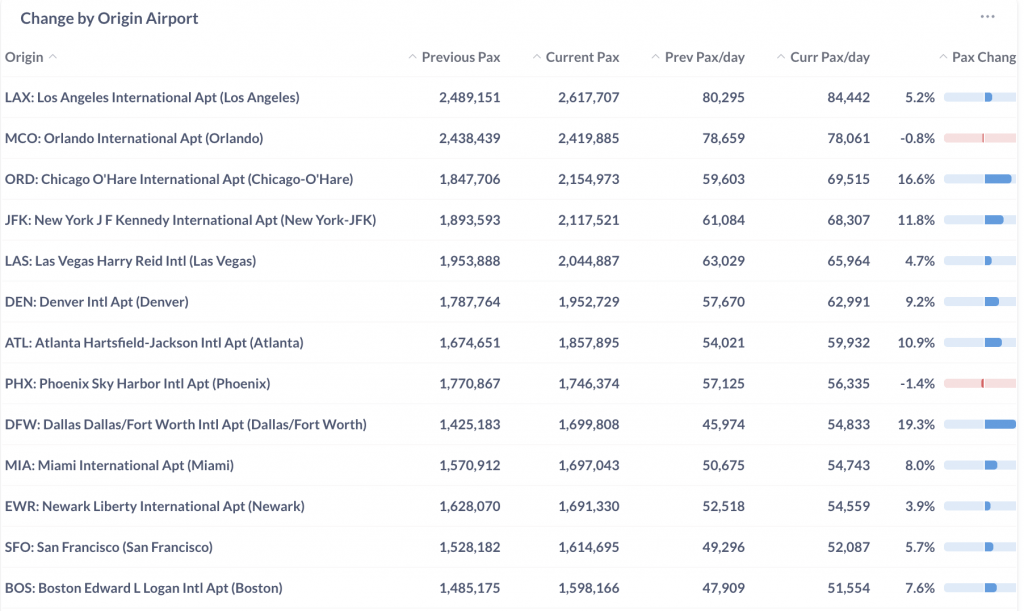Traffic and fare data by airline and route can provide valuable insights into market trends, demand, and competition. By analyzing this data, airlines can optimize their pricing strategies, plan their capacity, and make informed decisions about their route network. The data can also be used for market and competitive analysis, helping airlines identify profitable routes and gain a competitive advantage.
According to initial true O&D level data from FlightBI released this week, total US domestic air travel increased in March 2025 compared to February, reflecting typical seasonal trends. Likewise, U.S. international air travel saw a uptick, accompanied by a decrease in average airfares during the same period.
Volume Trend
In March 2025, U.S. domestic passenger numbers grew from 44.9 million in February to 55.7 million, which is 3.5% higher than the 53.8 million recorded in March 2024. In the international sector, passenger volumes increased from 17.4 million in February to 21.8 million in March.

Figure 1: US Domestic and International Air Traffic by Month
Airfare Trend
Airfares continued to decline in March 2025. The average gross fare fell from $205 in February to $197, while the average net fare dropped from $175 to $168 over the same period.

Figure 2: US Domestic Average Airfare by Month
Load Factor Trend
In March 2025, both Available Seat Miles (ASM) and Revenue Passenger Miles (RPM) jumped from the previous month. The average load factor for major U.S. airlines also rebounded to 80.9%, although it is still below the 83.4% recorded in March 2024, as shown in Figure 3.

Figure 3: US Airlines’ Average Load Factor by Month
Month Over Month Comparison
In March 2025, all major U.S. airlines saw an increase in daily traffic compared to February. Allegiant air (G4) led the growth with a 25.0% rise, followed by two other low-cost carriers: Spirit (NK) at 17.5% and Frontier (F9) at 16.9%.

Figure 4: Air Traffic by Dominant Marketing Airlines in February 2025 (Previous) vs. March 2025 (Current)
Airport-level changes presented a similar trend in March 2025. Chicago (ORD) led in traffic growth, with increases of 20.8%. Other airports including Dallas (DFW), Phoenix (PHX), Denver (DEN), Las Vegas (LAS) and Los Angeles (LAX), although achieved a double digit growth.

Figure 5: Air Traffic by Top Origin Airports in February 2025 (Previous) vs. March 2025 (Current)
Year Over Year Comparison
Between March 2024 and March 2025, Allegiant Air (G4) and Frontier (F9) led year-over-year growth, increased by 15.9% and 14.4%, respectively. In contrast, Spirit Airlines (NK) has not walked out the woods and reported a 13.5% decline in traffic. JetBlue (B6) and Southwest (WN) also saw a decrease in daily traffic compared to last year.

Figure 6: Air Traffic by Dominant Marketing Airlines in March 2025 (Current) vs. March 2024 (Previous)
From March 2024 to March 2025, most major U.S. airports experienced increased traffic, led by Dallas/Fort Worth (DFW), Chicago O’Hare (ORD), and New York (JFK), with year-over-year growth of 19.3%, 16.6%, and 11.8%, respectively. However, Phoenix (PHX) and Orlando (MCO) experienced traffic loss from last year.

Figure 7: Air Traffic by Top Origin Airport in March 2025 (Current) vs. March 2024 (Previous)
For more detailed information on traffic and fares by route and airline, please contact service@flightbi.com or request a demo of Fligence USOD. They will be able to provide you with customized information to meet your specific needs and requirements.
